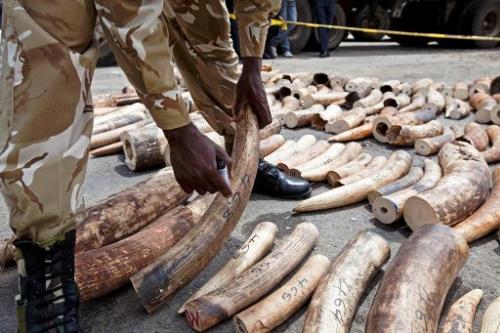Prime
Wildlife trafficking: A cancer threatening game conservation in EAC

A recent report by the United Nations Office on Drugs and Crime (UNODC), noted that poaching of rhinos and elephants was on the rise. The report detailed that crime gangs in East Africa fuelled by profits in the illicit trade threatened the existence of wildlife. PHOTO | FILE
What you need to know:
- In Uganda, wildlife protection authorities are working with communities around protected areas to put in place alternative livelihood options.
- Wildlife trafficking involves illegal poaching and trade of wildlife.
An unprecedented increase in wildlife trafficking across the seven East African Community (EAC) states has continued to worry conservationists as it threatens hundreds of animal species in the region.
Experts from conservation movements and media organizations say apart from threatening species of animals across the region, the illegal trade in bush meat and animal products has also led to viral disease outbreaks such as Ebola and Covid which have claimed hundreds of lives.
Daniel Ndizihirwe, the wildlife and protected areas manager at the World Wildlife Fund (WWF) Uganda November 13 said meat is illegally harvested from wild animals and sold for human consumption in different continents such as Africa, Asia, South America, Europe and others.
“Culture is one of the drivers of illegal bush meat poaching as people hunt bush meat for dignity, magic and curing different diseases. Most of communities adjacent to protected areas actually used to get meat from forests, but when these areas were gazetted, they couldn't get away with the protein that got from wild animals,” Ndizihirwe told this publication
Other drivers include agricultural activity encroachment, high poverty levels and growing populations in communities adjacent to the protected areas.
According to Ndizihirwe, commercial bush meat is highly concentrated in areas around Queen Elizabeth and Murchison Falls National Park adding that there is an increasing demand for bush meat in Uganda.
A recent USAID supported survey for East African states to achieve their mandate of conserving resources between November 2020 and May 2021 mentioned categories of species on demand including ungulates at 81%(kobs, buffalos, and other herbivorous animals), primates at 7%, rodents (5%), birds (3%), carnivores (3%), and pangolins (1%).
Top ten consumed ungulate species included Dik dik, buffalo, Impala, wildebeest, bush pig, warthog, zebra, gazelles, eland and the hartebeest.
The survey also showed that bush meat is available anytime on demand across the East African region. One can get bush meat all the time. Also, Uganda led the race with 83% compared to Tanzania's 68% and Kenya's 60%.
“Primary means of transportation of bush meat include Motorcycles, foot, public vehicles like buses and private vehicles, but foot means dominate in Uganda and Tanzania while Kenyans prefer transporting bush meat on motorbikes,” the survey indicated.
According to the 2021 annual report by Foundation Segré, an organization that promotes humanitarian, scientific, educational, artistic and environmental projects, Tanzania once had one of the largest elephant populations in Africa but industrial-scale elephant poaching wiped out approximately 60% of that population between 2009 and 2014.
Kenneth Kimitei, a Landscape Ecologist for the Tsavo Mkomazi, a transboundary landscape between Kenya and Tanzania says data recorded by scouts shows that poachers are using modern technology in conducting bush meat business using motorbikes as their main means of transportation.
Kimitei attributed the trade to “high rate of unemployment and other drivers like climatic conditions, ignorance, cultural beliefs, rush for quick money and improved transport systems.”
“The climatic conditions are not favorable as people grow crops and they dry up due to insufficient rains. People are then forced to depend on bush meat,” he explained
Lead players in the syndicate of the bush meat are informers who connect to different players like middlemen, brokers, transporters, buyers and sellers, and consumers.
Connection with disease outbreaks
Dr Daniel P Mdetele, an official at Wildlife Trade-One health TRAFFIC International East Africa linked bush meat trade and consumption to increased cases of zoonotic diseases like Anthrax, brucellosis, rift valley fever and rabies, which have claimed lives in East Africa over the years.
For WWF Uganda’s Ndihizirwe, wildlife silently harbor zoonotic disease pathogens.
“The microorganisms that cause most of these diseases are always in wild animals, but because these animals are having high levels of resistance, they can live with the pathogens. Once we get into contact with wildlife, through different blood, meat, we automatically get the disease and the disease can cause havoc to our lives,” he remarked.
Across East Africa, a surge in wildlife trafficking has resulted into declining wildlife species, ecosystem malfunctioning (impoverished ecosystem services), shrinking of the tourism industry, loss of cultural heritage, economic crisis and increased disease outbreaks such as anthrax, rift valley fever, foot and mouth disease.
Mitigating the problem
Across the nations, authorities have been put in place to control the trade that has largely put conservation at stake.
Mitigation options include effective management through multi-structural governance, national bans in bush meat trade and consumption, equipping of knowledge and protection of populations at higher risk of exposure, awareness creation, adequate nutrition, alternative livelihoods, enforcement, gaming (wildlife farming/ranching) among others.
In Uganda, the WWF is working with communities around protected areas to put in place alternative livelihood options.
“We have supported ten groups including reformed poachers but because of sensitization and awareness creation sessions, they stopped poaching and they are brought together as an association. Groups are made of men who stopped poaching. They are also with their wives and children,” Mr Ndihizirwe said.
He added: “We sit with them and adaptively agree on appropriate projects that they can undertake and then we support them including training to ensure that they know how to manage project enterprises and they can get money from them.”
Projects given to communities include commercial bee keeping and others. Communities engaged in projects are connected to private players for market and when they get money, they don't destabilize park resources.
WWF also makes a memorandum of understanding with the people living around national parks in a more systematic manner where the people can harvest from the resources for craft making.
In July 2022, the Tanzanian government, WildAid and the United Nations Development Program launched a 'Defend our Wildlife' campaign to bring an end to the illegal trafficking of wildlife through East Africa’s ports and cargo terminals, supported by international football stars, WildAid celebrity ambassadors, and our conservation partners.
National and transboundary efforts to keep wildlife trafficking in check have been let down by lack of enough law enforcement to engage the business and bring it to an end. Countries across the region have minimal capacity to enforce laws according to Mr. Kenneth Kimitei, a Landscape Ecologist for the Tsavo Mkomazi, a transboundary landscape between Kenya and Tanzania.
Some of the countries don't have enough when it comes to enforcing the laws. There are als weak policies when it comes to implementation. Likely, it is also due to corruption while others are doing what is possible to make efforts work.
Ms Jane Shuma, the behavior change manager at TRAFFICK International East Africa says behavior change can be instrumental in curbing wildlife trade practices in the region.
“Changing from undesirable to desirable behavior, difficult to doable can help though it requires substantial commitment of time, efforts and investment,” she says
She adds that in reducing illegal wildlife trade, there is a need for the media to work together with other stakeholders to highlight and expose the parties involved as well as suggesting solutions.
Helping journalists to report wildlife trafficking
In June 2022, through its East African Wildlife Journalism Project, Earth Journalism Network together with journalism organizations and conservation groups launched WildEye East Africa, a geo-mapping tool that enables and allows journalists and policymakers in the East African region to track and share data on court cases and convictions related to wildlife crime in East Africa.
This intended to address lack of data on criminal activity, something that had remained hidden from the public eye, and thwarted reporting on the multi-billion-dollar illegal wildlife trade, one of the major challenges facing wildlife crime reporters and investigators.
The development of this tool stemmed from a conviction that journalists and the media are key in addressing illegal wildlife trade and related activities. The media play a role of being change agents in preventing wildlife crime.



